The Influence of Hydrothermal Activity on the Long-Distance Migration and Accumulation of Hydrocarbons: A Case Study from the Y8 Area in the Songnan-Baodao Sag of Qiongdongnan Basin
Abstract
:1. Introduction
2. Geological Setting
2.1. Sedimentary and Stratum Characteristics
2.2. Tectonic Characteristics
3. Materials and Methods
3.1. Samples
3.2. Fluid Inclusion Analysis
3.3. Reconstruction of Thermal Burial History
3.4. Geochemical Analysis
4. Results and Discussion
4.1. New Evidence to Prove Hydrocarbon Accumulation Process in the Y8 Area
4.2. Evidences of Hydrothermal Activity in the Y8 Area
4.2.1. Abnormally High Th of Fluid Inclusions
4.2.2. Compositions in the Fluid Inclusions Coincide with Hydrocarbon Accumulation
4.2.3. Lower Tmax Values in Research Wells
4.2.4. Presence of Fluid Diapirs in the Y8 Area
4.3. Influence of Hydrothermal Activity on Long-Distance Hydrocarbon Migration and Accumulation
5. Conclusions
- (1)
- Two episodes of natural gas charging developed in the Y8 area, and the main peak of the fluid inclusion Th of the four research wells was 100–140 °C, which was significantly higher than the 60–90 °C formation temperature of the pre-Paleogene reservoir. Hydrothermal activity resulted in higher Th of fluid inclusions than the temperature of the corresponding reservoir in geological history.
- (2)
- According to the laser Raman spectrum analysis of fluid inclusions in the Y8 area, the compositions of fluid inclusions in the study area contained both natural gas and hydrothermal fluid compositions. The analysis of the geochemical data of the research wells showed that a Tmax value lower than the theoretical value was caused by hydrothermal activity after diagenesis. The fluid diapirs also confirmed the presence of hydrothermal activity around the Y8 area.
- (3)
- The influence of hydrothermal activity on the long-distance natural gas accumulation process was clarified. Hydrothermal activity caused “high temperature baking” in the reservoir, which made the formation temperature rise significantly in the period of natural gas charging. In the later period, the formation temperature rapidly dropped to the present temperature without hydrothermal activity.
Author Contributions
Funding
Institutional Review Board Statement
Informed Consent Statement
Data Availability Statement
Acknowledgments
Conflicts of Interest
References
- Pettingill, H.; Weimer, P. Worldwide deepwater exploration and production: Past, present, and future. Leading Edge 2002, 21, 371–376. [Google Scholar] [CrossRef]
- Zhang, G.; Qu, H.; Zhang, F.; Fan, Y. A basic distributional framework of global deepwater basins and hydrocarbon characteristics. Acta Pet. Sin. 2019, 40, 1–34. [Google Scholar]
- Zhang, G.; Mi, L.; Qu, H.; Zhang, H.; Xie, X.; Hu, S.; Zhang, Y. Petroleum geology of deep-water areas in offshore China. Acta Pet. Sin. 2013, 34, 1–14. [Google Scholar]
- Delgado, L.; Batezelli, A.; Luna, J. Petroleum geochemical characterization of Albian-Oligocene sequences in the Campos Basin: “Case study: Eastern Marlim oilfield, offshore, Brazil”. J. S. Am. Earth Sci. 2018, 88, 715–735. [Google Scholar] [CrossRef]
- Li, H.; Zhang, M.; Lau, H.C.; Fu, S. China’s deepwater development: Subsurface challenges and opportunities. J. Pet. Sci. Eng. 2020, 195, 107761. [Google Scholar] [CrossRef]
- Yu, Y.; Zhang, C.; Wang, L.; Li, S.; Hursthouse, A.; Huang, Y.; Cao, T. Sedimentary characteristics and genetic mechanism of a deep-water channel system in the Zhujiang Formation of Baiyun Sag, Pearl River Mouth Basin. Deep Sea Res. Part I Oceanogr. Res. Pap. 2020, 168, 103456. [Google Scholar] [CrossRef]
- Zhang, J.; Wu, S.; Hu, G.; Fan, T.-E.; Yu, B.; Lin, P.; Jiang, S. Sea-level control on the submarine fan architecture in a deepwater sequence of the Niger Delta Basin. Mar. Pet. Geol. 2018, 94, 179–197. [Google Scholar] [CrossRef]
- Wang, L.; Pan, J.; Yang, L. Present Conditions and Prospect of Global Deepwater Oil and Gas Exploration and Development. Pet. Sci. Technol. Forum 2020, 39, 31–37. [Google Scholar] [CrossRef]
- Zhang, Y.; Gan, J.; Xu, X.; Liang, G.; Li, X. The source and natural gas lateral migration accumulation model of Y8–1 gas bearing structure, east deep water in the Qiongdongnan Basin. Earth Sci. 2019, 44, 2609–2618. [Google Scholar]
- Wang, X.; Lu, Z.; Li, M.; Guo, H.; Zhu, Z.; Li, X.; Yang, C.; Zeng, B.; Wang, F.; Ran, Z. Petroleum Charging History of the Paleogene Sandstone Reservoirs in the Huangtong Sag of the Fushan Depression, South China Sea. Energies 2022, 15, 1374. [Google Scholar] [CrossRef]
- Yang, R.; Zhao, X.; Zhao, C.; Pu, X.; Liu, H.; Li, H.; Fu, L.; Tang, Y. Hydrocarbon Charging and Accumulation in the Permian Reservoirs of the Wumaying Buried Hill, Huanghua Depression, Bohai Bay Basin, China. Energies 2021, 14, 8109. [Google Scholar] [CrossRef]
- Kerkhof, A.M.V.D.; Hein, U.F. Fluid inclusion petrography. Lithos 2001, 55, 27–47. [Google Scholar] [CrossRef]
- Jing, C.; Wang, Z.; Zhang, D. Research progress on fluid inclusion applied to the determination of hydrocarbon accumulation period. Sino-Glob. Energy 2018, 23, 48–54. [Google Scholar]
- Jia, Y.; Hu, P.; Zhang, M.; Zhang, T.; Chen, K.; Cong, Y. Characteristics of fluid inclusions and their constraints on timing of hydrocarbon filling in the Yacheng area of Qiongdongnan basin, South China. Acta Sedimentol. Sin. 2001, 30, 189–196. [Google Scholar]
- Su, A.; Chen, H.; Chen, X.; Liu, H.; Liu, Y.; Lei, M. New insight into origin, accumulation and escape of natural gas in the Songdong and Baodao regions in the eastern Qiongdongnan basin, South China Sea. J. Nat. Gas Sci. Eng. 2018, 52, 467–483. [Google Scholar] [CrossRef]
- Wang, L.; Zhu, J.; Zhuo, H.; Sun, Z.; Song, A.; Zhang, H. Seismic characteristics and mechanism of fluid flow structures in the central depression of Qiongdongnan basin, northern margin of South China Sea. Int. Geol. Rev. 2020, 62, 1–23. [Google Scholar] [CrossRef]
- Wang, Z.; Shi, X.; Yang, J.; Huang, B.; Sun, Z.; Wang, Y.; Jiang, H.; Yu, C.; Yang, X. Analyses on the tectonic thermal evolution and influence factors in the deep-water Qiongdongnan Basin. Acta Oceanol. Sin. 2015, 33, 107–117. [Google Scholar] [CrossRef]
- White, D.E. Thermal waters of volcanic origin. GSA Bull. 1957, 68, 1637–1658. [Google Scholar] [CrossRef]
- Zeng, Z. Submarine Hydrothermal Geology; Science Press: Beijing, China, 2011. [Google Scholar]
- Zhu, J.; Li, S.; Sun, X.; Zhu, J.; Xin, M.; Xu, H. Discovery of early tertiary hydrothermal activity and its significance in oil/gas geology, Dongpu Depression, Henan Province, China. Chin. J. Geochem. 1994, 13, 270–283. [Google Scholar]
- Marchig, V.; Gundlach, H.; Möller, P.; Schley, F. Some geochemical indicators for discrimination between diagenetic and hydrothermal metalliferous sediments. Mar. Geol. 1982, 50, 241–256. [Google Scholar] [CrossRef]
- Kholodov, V.N. Mud Volcanoes, Their Distribution Regularities and Genesis: Communication 1. Mud Volcanic Provinces and Morphology of Mud Volcanoes. Lithol. Miner. Resour. 2002, 37, 197–209. [Google Scholar] [CrossRef]
- Kopf, A.J. Significance of mud volcanism. Rev. Geophys. 2002, 40, 1005. [Google Scholar] [CrossRef] [Green Version]
- McKibben, M.A.; Williams, A.E.; Hall, G.E.M. Solubility and transport of plantinum-group elements and Au in saline hydrothermal fluids; constraints from geothermal brine data. Econ. Geol. 1990, 85, 1926–1934. [Google Scholar] [CrossRef]
- Liu, W.; Zhang, K.; Jiang, Z.; Jiang, S.; Song, Y.; Jia, C.; Huang, Y.; Wen, M.; Liu, T.; Xie, X.; et al. Effect of the hydrothermal activity in the Lower Yangtze region on marine shale gas enrichment: A case study of Lower Cambrian and Upper Ordovician-Lower Silurian shales in Jiangye-1 well. Open Geosci. 2018, 10, 582–592. [Google Scholar] [CrossRef]
- Venkatesan, M.; Ruth, E.; Rao, P.; Nath, B.; Rao, B. Hydrothermal petroleum in the sediments of the Andaman Backarc Basin, Indian Ocean. Appl. Geochem. 2003, 18, 845–861. [Google Scholar] [CrossRef]
- Ji, L.; Li, J.; Zhang, M.; Lu, H.; He, C.; Jin, P.; Ma, B. Effects of lacustrine hydrothermal activity on the organic matter input of source rocks during the Yanchang period in the Ordos Basin. Mar. Pet. Geol. 2020, 125, 104868. [Google Scholar] [CrossRef]
- Lavoie, D.; Chi, G.; Brennan-Alpert, P.; DesRochers, A.; Bertrand, R. Hydrothermal dolomitization in the Lower Ordovician Romaine Formation of the Anticosti Basin: Significance for hydrocarbon exploration. Bull. Can. Pet. Geol. 2005, 53, 454–471. [Google Scholar] [CrossRef]
- Lü, X.; Yang, N.; Zhou, X.; Yang, H.; Li, J. Influence of Ordovician carbonate reservoir beds in Tarim Basin by faulting. Sci. China Ser. D Earth Sci. 2008, 51, 53–60. [Google Scholar] [CrossRef]
- Smith, L. Origin and reservoir characteristics of Upper Ordovician TrentonBlack River hydrothermal dolomite reservoirs in New York. AAPG Bull. 2006, 90, 1691–1718. [Google Scholar] [CrossRef] [Green Version]
- Xiao, D.; Cao, J.; Luo, B.; Tan, X.; Liu, H.; Zhang, B.; Yang, X.; Li, Y. On the dolomite reservoirs formed by dissolution: Differential eogenetic versus hydrothermal in the lower Permian Sichuan Basin, southwestern China. AAPG Bull. 2020, 104, 1405–1438. [Google Scholar] [CrossRef]
- Tian, T.; Yang, P.; Ren, Z.; Fu, D.; Zhou, S.; Yang, F.; Li, J. Hydrocarbon migration and accumulation in the Lower Cambrian to Neoproterozoic reservoirs in the Micangshan tectonic zone, China: New evidence of fluid inclusions. Energy Rep. 2020, 6, 721–733. [Google Scholar] [CrossRef]
- Horita, J.; Berndt, M.E. Abiogenic Methane Formation and Isotopic Fractionation Under Hydrothermal Conditions. Science 1999, 285, 1055–1057. [Google Scholar] [CrossRef] [PubMed]
- Shu, Y.; Sang, S.-X.; Lin, Y.-X.; Zhou, X.-Z.; Wang, H.; Wang, Z.-L. The influence of magmatic-hydrothermal activities on porosity and permeability of sandstone reservoirs in the Linxing area, Ordos Basin, Northern China. J. Southeast Asian Earth Sci. 2021, 213, 104741. [Google Scholar] [CrossRef]
- Zhang, K.; Liu, R.; Liu, Z.; Li, B.; Han, J.; Zhao, K. Influence of volcanic and hydrothermal activity on organic matter enrichment in the Upper Triassic Yanchang Formation, southern Ordos Basin, Central China. Mar. Pet. Geol. 2019, 112, 104059. [Google Scholar] [CrossRef]
- Zhou, D.; Ru, K.; Chen, H.-Z. Kinematics of Cenozoic extension on the South China Sea continental margin and its implications for the tectonic evolution of the region. Tectonophysics 1995, 251, 161–177. [Google Scholar] [CrossRef]
- Zhao, Z.; Sun, Z.; Wang, Z.; Sun, Z.; Liu, J.; Zhang, C. The high resolution sedimentary filling in Qiongdongnan Basin, Northern South China Sea. Mar. Geol. 2015, 361, 11–24. [Google Scholar] [CrossRef]
- Huang, H.; Huang, B.; Huang, Y.; Li, X.; Tian, H. Condensate origin and hydrocarbon accumulation mechanism of the deepwater giant gas field in western South China Sea: A case study of Lingshui 17-2 gas field in Qiongdongnan Basin. Pet. Explor. Dev. 2017, 44, 409–417. [Google Scholar] [CrossRef]
- Ding, W.; Hou, D.; Zhang, W.; He, D.; Cheng, X. A new genetic type of natural gases and origin analysis in Northern Songnan-Baodao Sag, Qiongdongnan Basin, South China Sea. J. Nat. Gas Sci. Eng. 2018, 50, 384–398. [Google Scholar] [CrossRef]
- Yang, J.; Yang, X.; Zhou, X.; Gan, J.; Song, A.; Jiang, F.; Yang, L. Characteristics of inversion structure belts and their hydrocarbon geological significance in the Songnan-Baodao Sag in deep water area of the Qiongdongnan Basin. Haiyang Xuebao 2019, 41, 97–106. [Google Scholar]
- Su, M.; Xie, X.; Wang, Z.; Jiang, T.; Zhang, C.; He, Y. Sedimentary evolution of the Central Canyon System in the Qiongdongnan Basin, northern South China Sea. Pet. Res. 2016, 1, 81–92. [Google Scholar] [CrossRef]
- Mi, L.; Yuan, Y.; Zhang, G.; Hu, S.; He, L.; Yang, S. Characteristics and genesis of geothermal field in deep water area of the northern South China Sea. Acta Pet. Sin. 2009, 30, 27–32. [Google Scholar]
- Zhu, W.; Xie, X.; Wang, Z.; Zhang, D.; Zhang, C.; Cao, L.; Shao, L. New insights on the origin of the basement of the Xisha Uplift, South China Sea. Sci. China Earth Sci. 2017, 60, 2214–2222. [Google Scholar] [CrossRef]
- Wang, Z.; Sun, Z.; Zhu, J.; Guo, M.; Jiang, R. Natural gas geological characteritics and great discovery of large gas fields in deep water area of the western South China Sea. Nat. Gas Ind. 2015, 35, 11–20. [Google Scholar]
- Ru, K.; Pigott, J. Episodic rifting and subsidence in the Soth China Sea. AAPG Bull. 1986, 70, 1136–1155. [Google Scholar]
- Taylor, B.; Hayes, D. Origin and History of the South China Sea Basin. In The Tectonic and Geologic Evolution of Southeast Asian Seas and Islands: Part 2; Hayes, D.E., Ed.; Geophysical Monograph Series; American Geophysical Union: Washington, DC, USA, 1983. [Google Scholar]
- Xie, W.; Zhang, Y.; Sun, Z.; Jiang, J. Characteristics and formation mechanism of faults in Qiongdongnan Basin. Mar. Geol. Quat. Geol. 2007, 27, 71–78. [Google Scholar]
- Xiao, X.M.; Xiong, M.; Tian, H.; Wilkins, R.W.T.; Huang, B.J.; Tang, Y.C. Determination of the source area of the Ya13–1 gas pool in the Qiongdongnan Basin, South China Sea. Org. Geochem. 2006, 37, 990–1002. [Google Scholar] [CrossRef]
- Huang, B.; Xiao, X.; Li, X. Geochemistry and origins of natural gases in the Yinggehai and Qiongdongnan basins, offshore South China Sea. Org. Geochem. 2003, 34, 1009–1025. [Google Scholar] [CrossRef]
- Hu, B.; Wang, L.; Yan, W.; Liu, S.; Cai, D.; Zhang, G.; Zhong, K.; Pei, J.; Sun, B. The tectonic evolution of the Qiongdongnan Basin in the northern margin of the South China Sea. J. Southeast Asian Earth Sci. 2013, 77, 163–182. [Google Scholar] [CrossRef]
- Aplin, A.; Larter, S.; Bigge, M.; Macleod, G.; Swarbrick, R.; Grunberger, D. PVTX history of the North Sea’s Judy oilfield. J. Geochem. Explor. 2000, 69, 641–644. [Google Scholar] [CrossRef]
- Parnell, J. Potential of palaeofluid analysis for understanding oil charge history. Geofluids 2010, 10, 73–82. [Google Scholar] [CrossRef]
- Frezzotti, M.L.; Tecce, F.; Casagli, A. Raman spectroscopy for fluid inclusion analysis. J. Geochem. Explor. 2012, 112, 1–20. [Google Scholar] [CrossRef]
- Mernagh, T.; Wilde, A. The use of the laser Raman microprobe for the determination of salinity in fluid inclusions. Geochim. Cosmochim. Acta 1989, 53, 765–771. [Google Scholar] [CrossRef]
- Lu, Z. Fluid Inclusions; Science Press: Beijing, China, 2004. [Google Scholar]
- Hakimi, M.H.; Al-Matary, A.M.; Hersi, O.S. Burial and thermal history reconstruction of the Mukalla-Sayhut Basin in the Gulf of Aden, Yemen: Implications for hydrocarbon generation from Paleocene potential source rock. J. Afr. Earth Sci. 2018, 144, 59–75. [Google Scholar] [CrossRef]
- El Gawad, E.A.A.; Ghanem, M.F.; Lotfy, M.M.; Mousa, D.A.; Temraz, M.G.; Shehata, A. Burial and thermal history simulation of the subsurface Paleozoic source rocks in Faghur basin, north Western Desert, Egypt: Implication for hydrocarbon generation and expulsion history. Egypt. J. Pet. 2019, 28, 261–271. [Google Scholar] [CrossRef]
- Dowdle, W.L.; Cobb, W.M. Static Formation Temperature From Well Logs—An Empirical Method. J. Pet. Technol. 1975, 27, 1326–1330. [Google Scholar] [CrossRef]
- Shi, X.; Wang, Z.; Jlang, H.; Sun, Z.; Sun, Z.; Yang, J.; Yu, C.; Yang, X. Vertial variation of geothermal parameters in rifted basins and heat flow distribution features of the Qiongdongnan Basin. Chin. J. Geophys. 2015, 58, 939–952. [Google Scholar]
- Burruss, R.; Cercone, K.; Harris, P. Time of hydrocarbon migration, evidence from fluid inclusions in calcite cements, tectonics and burial history. SEPM Spec. Publ. 1985, 36, 277–289. [Google Scholar]
- Zhu, J.; Pei, J.; Sun, Z.; Guo, M.; Yao, Z.; Yang, B.; Hu, X. Feature of neotectonism and its control on late hydrocarbon accumulation in Qiongdongnan Basin. Nat. Gas Geosci. 2011, 22, 649–656. [Google Scholar]
- Xu, Z.; Jiang, S.; Liu, L.; Wu, K.; Li, R.; Liu, Z.; Shao, M.; Jia, K.; Feng, Y. Natural gas accumulation processes of tight sandstone reservoirs in deep formations of Songliao Basin, NE China. J. Nat. Gas Sci. Eng. 2020, 83, 103610. [Google Scholar] [CrossRef]
- Yang, R.; Zhao, X.; Liu, H.; Zhao, C.; Li, H.; Pu, X.; Fu, L.; Li, C. Hydrocarbon charging and accumulation in the Permian reservoir of Wangguantun Buried Hill in Huanghua Depression, Bohai Bay Basin, China. J. Pet. Sci. Eng. 2020, 199, 108297. [Google Scholar] [CrossRef]
- Zuo, Y.; Qiu, N.-S.; Hao, Q.-Q.; Pang, X.-Q.; Gao, X.; Wang, X.-J.; Luo, X.-P.; Zhao, Z.-Y. Geothermal regime and source rock thermal evolution in the Chagan sag, Inner Mongolia, northern China. Mar. Pet. Geol. 2015, 59, 245–267. [Google Scholar] [CrossRef]
- Espitalié, J. Use of Tmax as a Maturation Index for Different Types of Organic Matter. Comparison with Vitrinite Reflectance. In Thermal Modelling in Sedimentary Basins; Burrus, J., Ed.; Publications de l'Institut Français du Pétrole/Institut Français du Pétrole, 44; Editions Technip: Paris, France, 1986; pp. 475–496. [Google Scholar]
- Baskin, D.K. Atomic H/C Ratio of Kerogen as an Estimate of Thermal Maturity and Organic Matter Conversion. AAPG Bull. 1997, 81, 1437–1450. [Google Scholar] [CrossRef]
- Wei, D.; Jinqiang, L.; Wei, Z.; Zenggui, K.; Tong, Z.; Yulin, H. Typical characteristics of fracture-filling hydrate-charged reservoirs caused by heterogeneous fluid flow in the Qiongdongnan Basin, northern south China sea. Mar. Pet. Geol. 2020, 124, 104810. [Google Scholar] [CrossRef]
- Man, X.; Zhu, J.; Yao, Z.; Wu, J.; Wang, L. The characteristic of Mud-Fluid diapir and its control on hydrocarbon accumulation in deep water area, Qiongdongnan Basin. Contrib. Geol. Miner. Resour. Res. 2018, 33, 257–263. [Google Scholar]
- Dimitrov, L. Mud volcanoes—the most important pathway for degassing deeply buried sediments. Earth-Sci. Rev. 2002, 59, 49–76. [Google Scholar] [CrossRef]
- Jia, R.; Fan, C.; Liu, B.; Fu, X.; Jin, Y. Analysis of Natural Hydraulic Fracture Risk of Mudstone Cap Rocks in XD Block of Central Depression in Yinggehai Basin, South China Sea. Energies 2021, 14, 4085. [Google Scholar] [CrossRef]
- Wu, X.; Liang, Q.; Ma, Y.; Shi, Y.; Xia, Z.; Liu, L.; Haeckel, M. Submarine Landslides and their Distribution in the Gas Hydrate Area on the North Slope of the South China Sea. Energies 2018, 11, 3481. [Google Scholar] [CrossRef] [Green Version]
- Wiedicke, M.; Neben, S.; Spiess, V. Mud volcanoes at the front of the Makran accretionary complex, Pakistan. Mar. Geol. 2001, 172, 57–73. [Google Scholar] [CrossRef]
- Song, Y.; Zhao, C.; Zhang, G.; Song, H.; Shan, J.; Chen, L. Research on tectono-thermal modeling for Qiongdongnan Basin and Pearl River Mouth Basin in the northern South China Sea. Chin. J. Geophys. 2011, 54, 057–3069. [Google Scholar] [CrossRef]

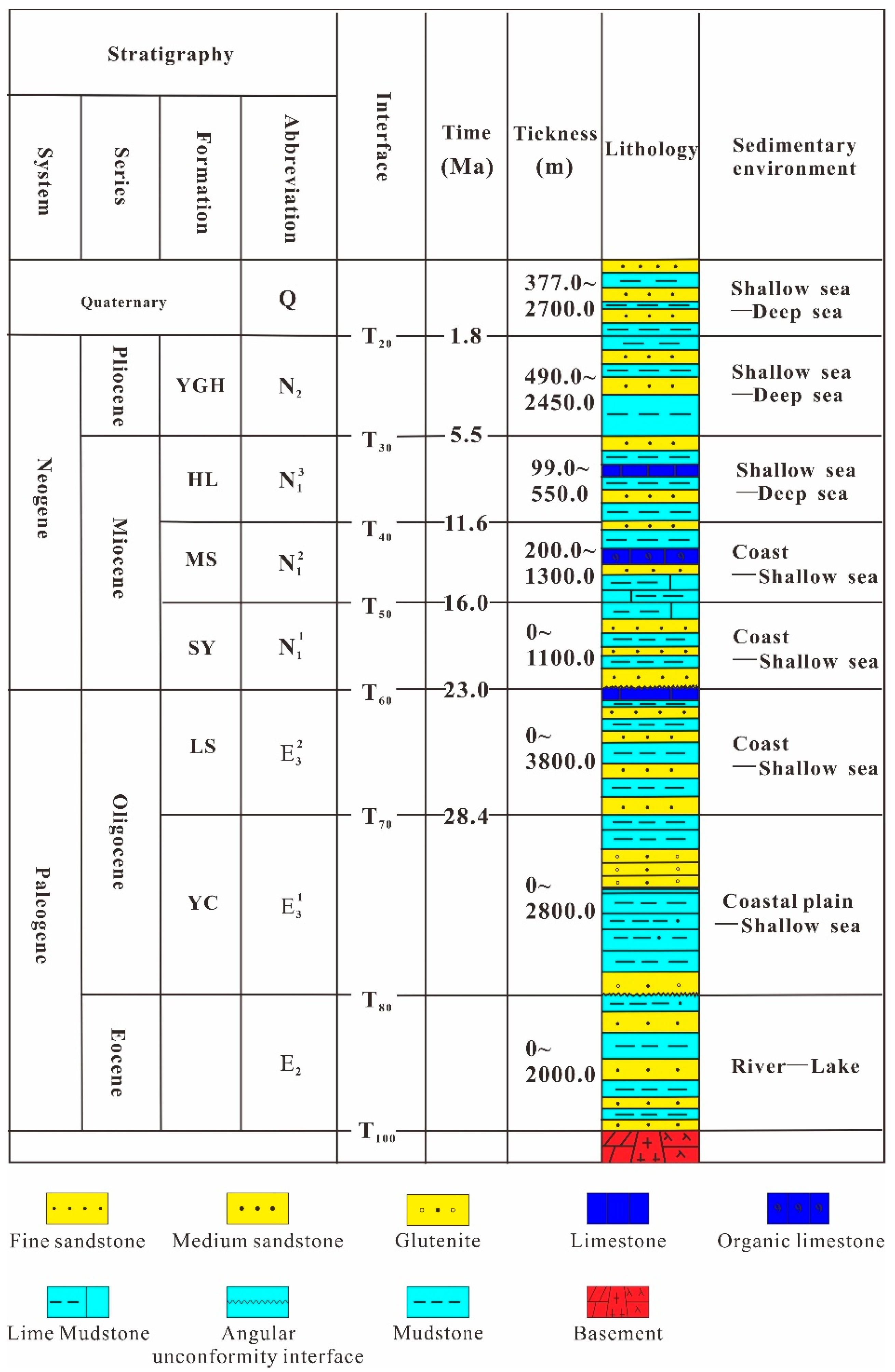
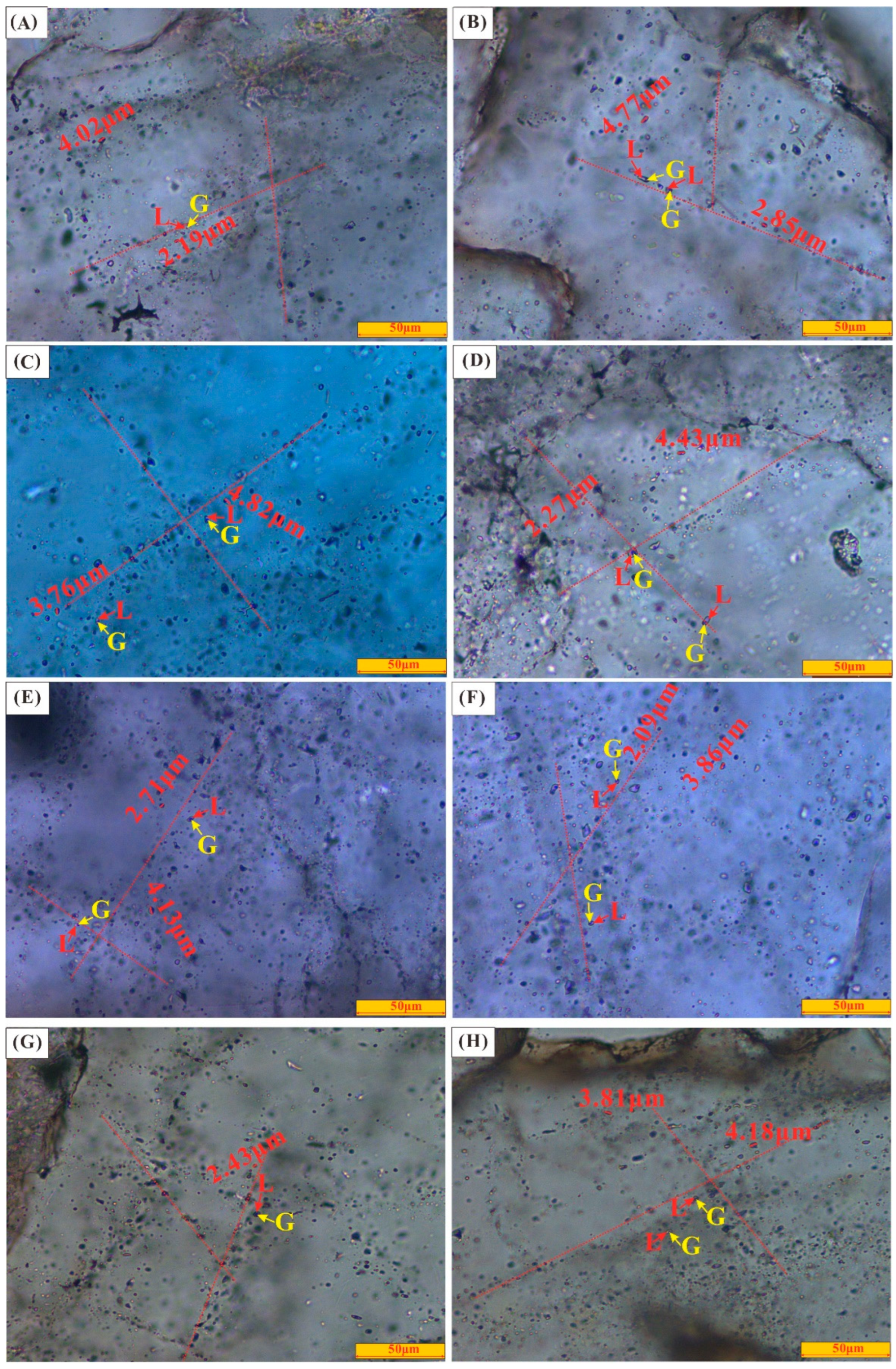

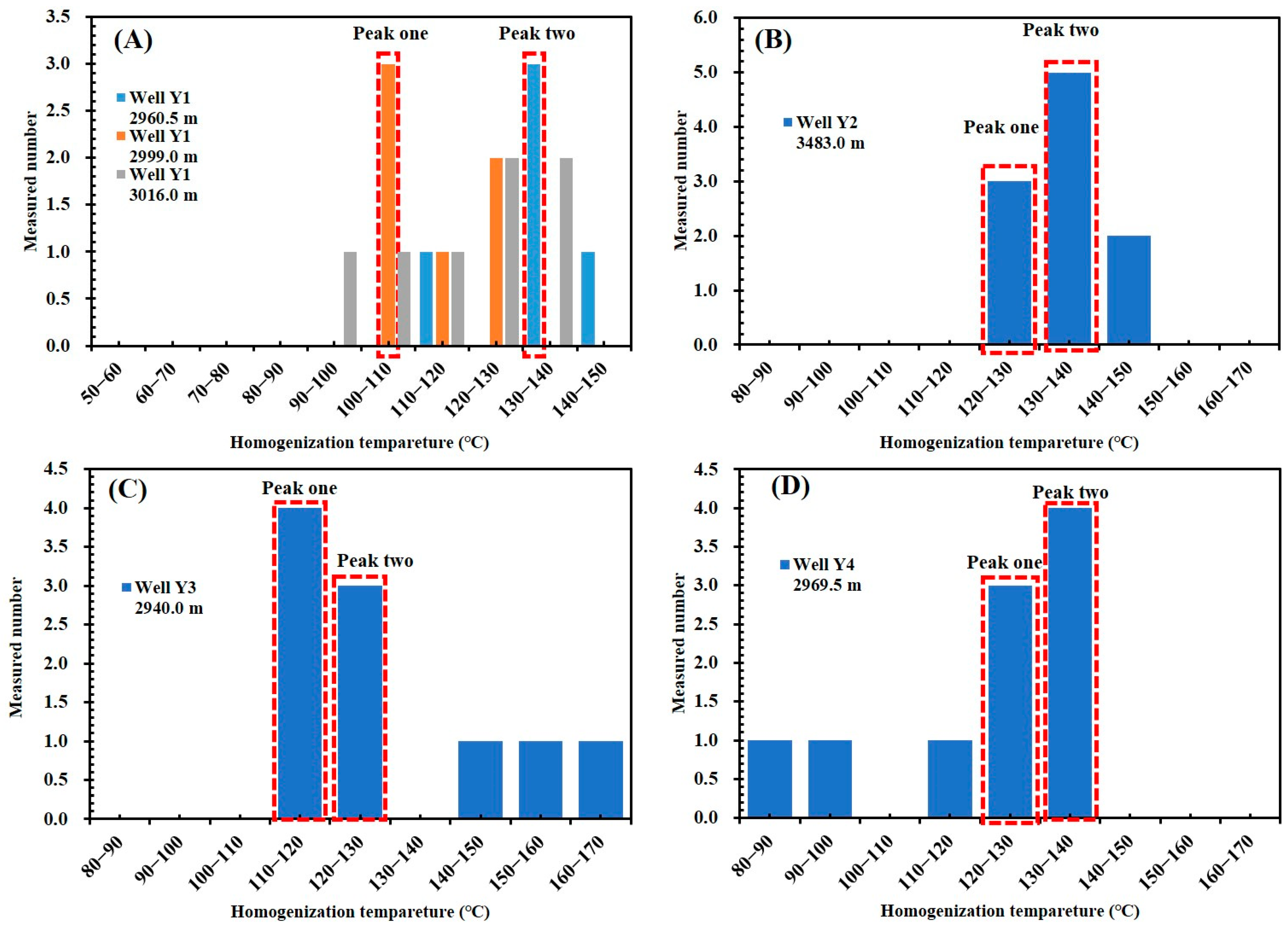

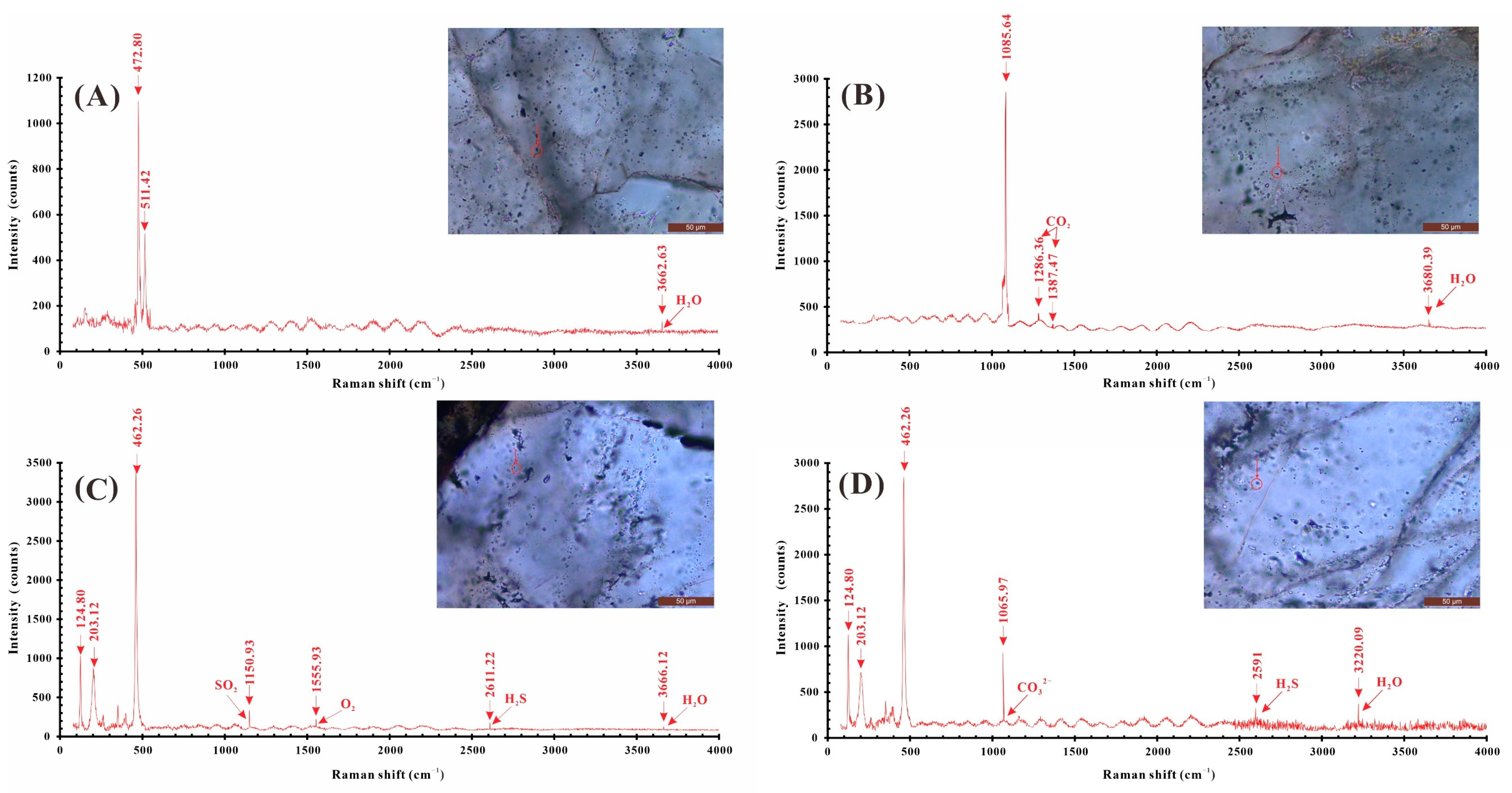

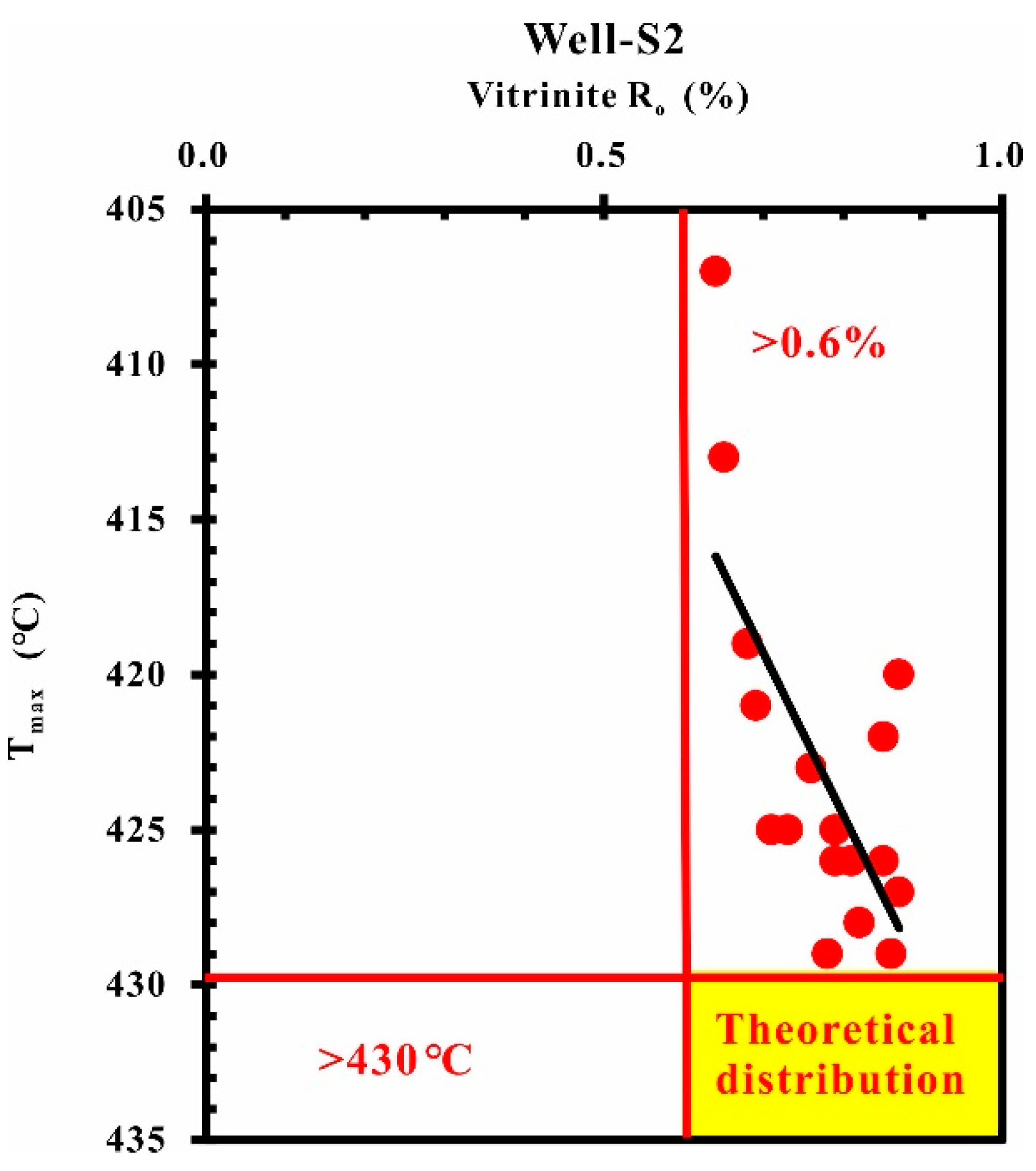


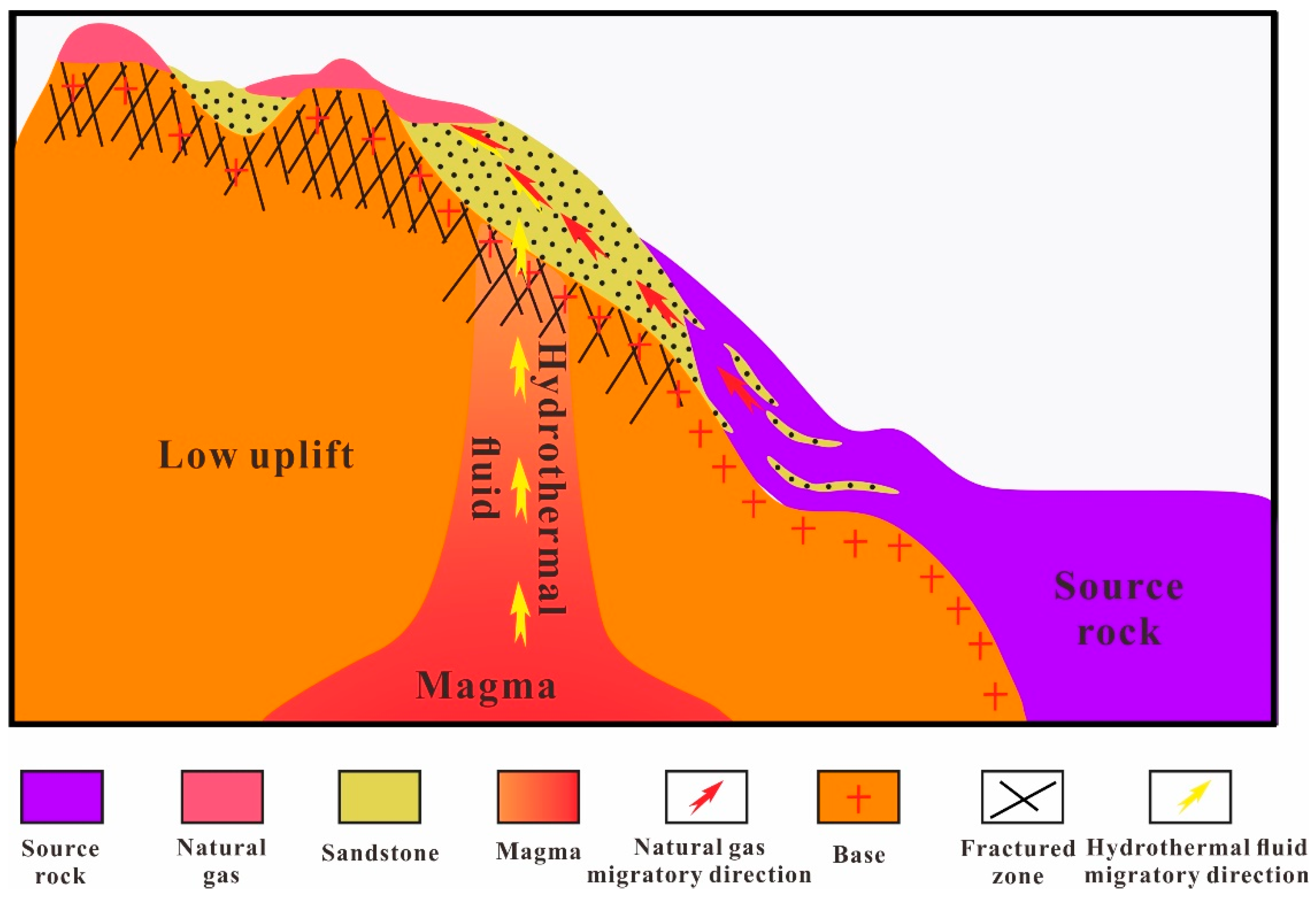
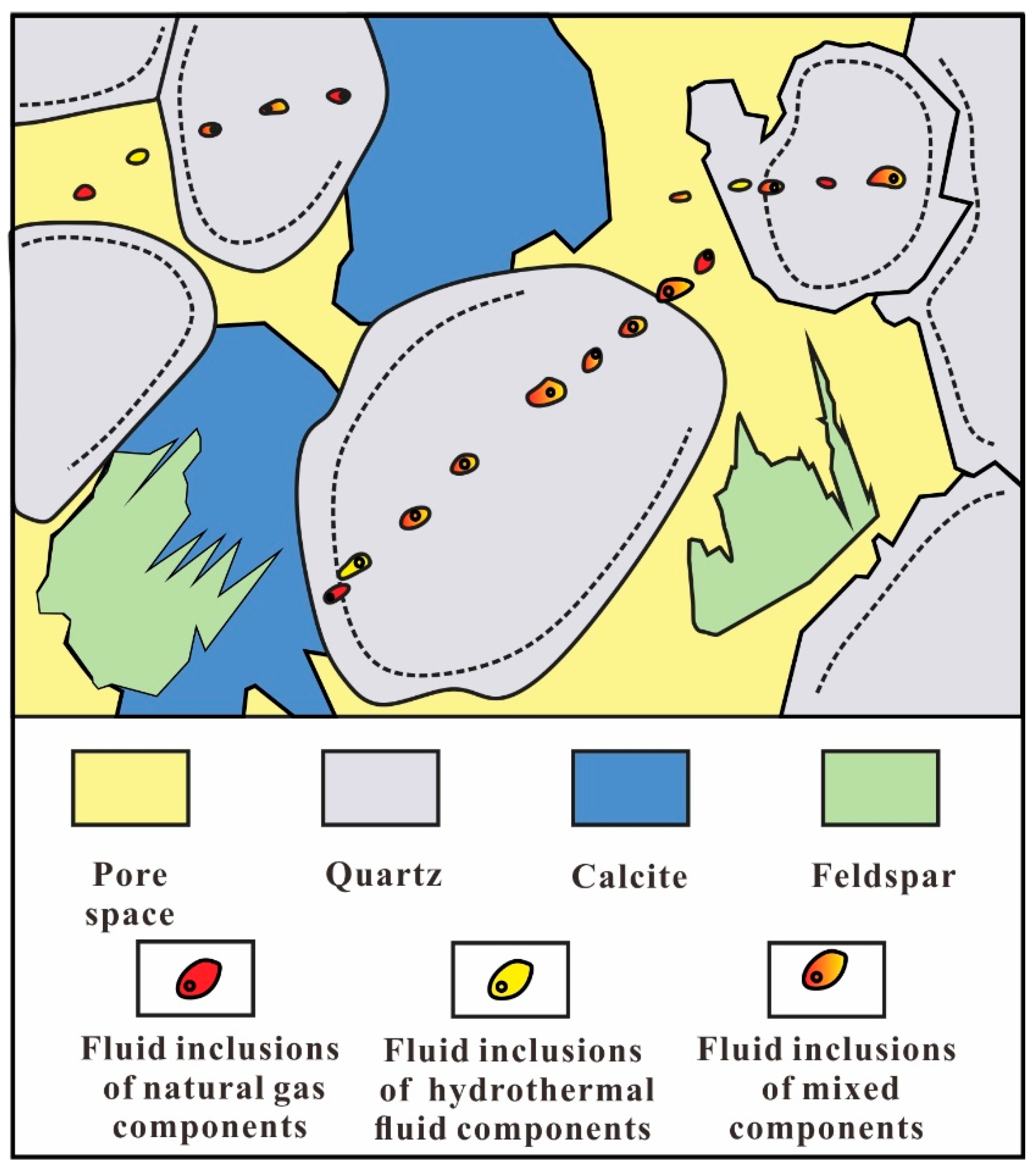

| Eonothem | System | Series | Formation | Age of the Bottom (Ma) | Bottom Seismic Marker Layer | Tectonic Evolution Stage |
|---|---|---|---|---|---|---|
| Cenozoic | Neogene | Holocene-Pleistocene | Ledong | 2.48 | T20 | Neotectonic |
| Pliocene | Yinggehai | 5.4 | T30 | |||
| Miocene | Huangliu | 11.5 | T40 | |||
| Meishan | 15 | T50 | Thermal subsidence | |||
| Sanya | 23.3 | T60 | ||||
| Paleogene | Oligocene | Lingshui | 30 | T70 | Late episode of syn-rift | |
| Yacheng | 32 | T80 | Middle episode of syn-rift | |||
| Eocene | 56.5 | T100 | Early episode of syn-rift | |||
| Pre-Cenozoic | Pre rift |
| Sample Number | Well | Depth (m) | Formation | Lithology |
|---|---|---|---|---|
| X1 | Y1 | 2960.5~3016.0 | Weathering crust in basement | Mixed glutenite |
| X2 | Y2 | 3174.0 | Yacheng | Gravel-bearing Coarse Sandstone |
| X3 | Y2 | 3483.0 | Weathering crust in Pre-Paleogene | Granite |
| X4 | Y3 | 2940.0 | Weathering crust in Pre-Paleogene | Granite |
| X5 | Y4 | 2969.5 | Semiweathered fracture zone in Mesozoic | Granite |
Publisher’s Note: MDPI stays neutral with regard to jurisdictional claims in published maps and institutional affiliations. |
© 2022 by the authors. Licensee MDPI, Basel, Switzerland. This article is an open access article distributed under the terms and conditions of the Creative Commons Attribution (CC BY) license (https://creativecommons.org/licenses/by/4.0/).
Share and Cite
Gan, J.; Xiong, S.; Liang, G.; Gao, Z.; Li, X.; Yang, W.; Jiang, Z.; Wang, Y. The Influence of Hydrothermal Activity on the Long-Distance Migration and Accumulation of Hydrocarbons: A Case Study from the Y8 Area in the Songnan-Baodao Sag of Qiongdongnan Basin. Energies 2022, 15, 3089. https://doi.org/10.3390/en15093089
Gan J, Xiong S, Liang G, Gao Z, Li X, Yang W, Jiang Z, Wang Y. The Influence of Hydrothermal Activity on the Long-Distance Migration and Accumulation of Hydrocarbons: A Case Study from the Y8 Area in the Songnan-Baodao Sag of Qiongdongnan Basin. Energies. 2022; 15(9):3089. https://doi.org/10.3390/en15093089
Chicago/Turabian StyleGan, Jun, Shuling Xiong, Gang Liang, Zhiye Gao, Xing Li, Wei Yang, Zhenxue Jiang, and Yaohua Wang. 2022. "The Influence of Hydrothermal Activity on the Long-Distance Migration and Accumulation of Hydrocarbons: A Case Study from the Y8 Area in the Songnan-Baodao Sag of Qiongdongnan Basin" Energies 15, no. 9: 3089. https://doi.org/10.3390/en15093089





